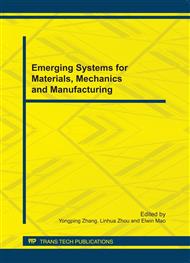[1]
C.K. Zhang, C. Li: Rule-matching based method for RFID event processing, Proceedings - 4th International Conference on Genetic and Evolutionary Computing, ICGEC 2010, pp.272-275.
DOI: 10.1109/icgec.2010.74
Google Scholar
[2]
H. Gonzalez, J. Han and X. Li: FlowCube: constructing RFID flowcubes for multi- dimensional analysis of commodity flows, Proceedings the 2006 International Conference on Very Large Data Bases (VLDB'06). Seoul: ACM, 2006: 834-845.
Google Scholar
[3]
C.H. Lee , C.W. Chung: RFID data processing in supply chain management using a path encoding scheme, IEEE Transactions on Knowledge and Data Engineering, v23, n5, pp.742-758, (2011).
DOI: 10.1109/tkde.2010.136
Google Scholar
[4]
J. Song, H, Kim: The RFID middleware system supporting context- aware access control service [DB/OL] . Advanced Communication Technology, 2006: 863-866.
DOI: 10.1109/icact.2006.206099
Google Scholar
[5]
S. Ju, D. Wang and B. Du: Research and development of QoS for RFID middleware, ICCMS 2010-2010 International Conference on Computer Modeling and Simulation, v2, pp.397-402, (2010).
DOI: 10.1109/iccms.2010.280
Google Scholar
[6]
H. Zhang, W. Ryu and B. Hong: A test data generation tool for testing RFID middleware, 40th International Conference on Computers and Industrial Engineering: Soft Computing Techniques for Advanced Manufacturing and Service Systems, CIE40 (2010).
DOI: 10.1109/iccie.2010.5668290
Google Scholar
[7]
A. Nakamura, S. Hayamizu: Topic-dependent N-gram models based on optimization of context lengths in LDA, Proceedings of the 11th Annual Conference of the International Speech Communication Association, INTERSPEECH 2010, pp.3066-3069, (2010).
DOI: 10.21437/interspeech.2010-763
Google Scholar
[8]
S. Buthpitiya, Y. Zhang and A. Dey: n-gram geo-trace modeling, Lecture Notes in Computer Science (including subseries Lecture Notes in Artificial Intelligence and Lecture Notes in Bioinformatics), v 6696 LNCS, pp.97-114, 2011, Pervasive Computing-9th International Conference, Pervasive (2011).
DOI: 10.1007/978-3-642-21726-5_7
Google Scholar
[9]
Z. Su, Q. Yang and Y. Lu: WhatNext: a prediction system for web requests using N-gram sequence models, Proceedings of the First International Conference Web Information Systems and Engineering, 2000: 200–207.
DOI: 10.1109/wise.2000.882395
Google Scholar
[10]
J. Yu, Y. Yu and X. Lu: Web prediction based on hybrid Markov model, WSEAS Transactions on Computers, v5, n9, pp.2137-2141, September (2006).
Google Scholar


